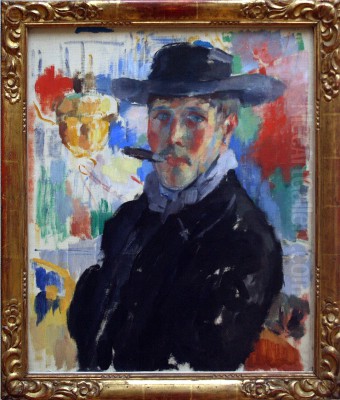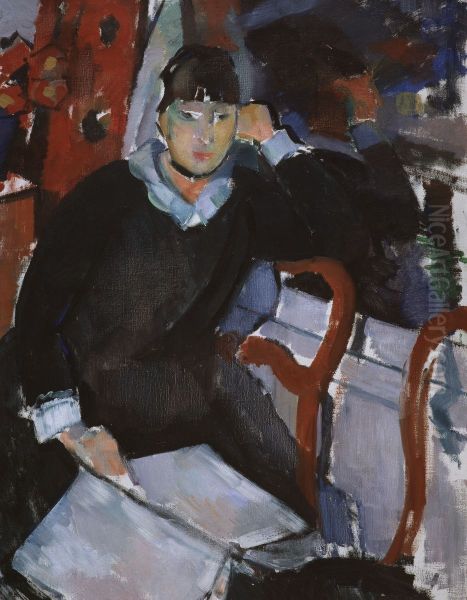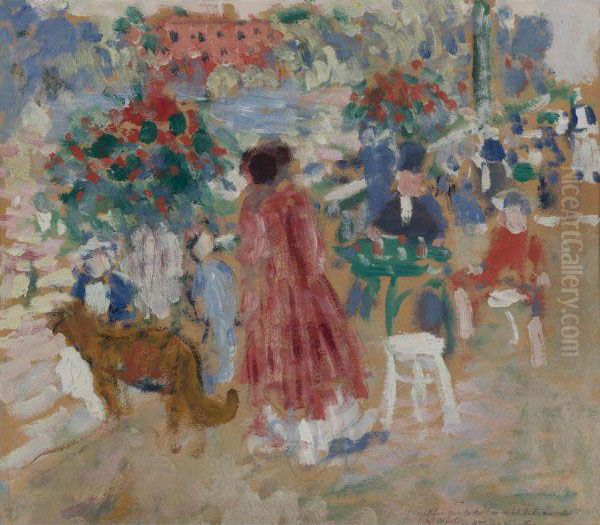Introduction: A Brief, Brilliant Career

Rik Wouters (1882-1916) stands as a pivotal figure in Belgian art history, celebrated primarily as a painter, sculptor, and printmaker associated with Fauvism. Despite a tragically short life cut short at the age of 33, Wouters produced a vibrant and influential body of work characterized by its innovative use of color, dynamic brushwork, and intimate portrayal of everyday life. His art bridges Impressionist sensibilities with the bold experiments of early 20th-century Modernism, leaving an indelible mark on the Belgian art scene and securing his place as one of its most cherished modern artists. His journey, marked by both artistic triumphs and personal hardships, offers a compelling glimpse into the creative spirit navigating the turbulent currents of its time.
Early Life and Artistic Foundations
Hendrik Emil (Rik) Wouters was born in Mechelen, Belgium, in 1882. His artistic inclinations were nurtured from a young age within a family deeply rooted in craftsmanship. His father and uncle were furniture carvers, and Rik initially learned the art of wood carving in his father's workshop. This early exposure to sculpting and working with form undoubtedly laid a foundation for his later three-dimensional work. Seeking formal training, Wouters enrolled at the Royal Academy of Fine Arts in Brussels.
At the Academy, he honed his skills, notably studying sculpture 'from nature' under the guidance of Charles Van der Stappen, a prominent Belgian sculptor of the time. This academic training provided him with technical proficiency, but Wouters' artistic vision soon expanded beyond traditional constraints. His education was not confined to the classroom; visits to museums and galleries exposed him to the revolutionary works emerging across Europe, setting the stage for his unique artistic synthesis.
Influences and the Embrace of Modernism
Rik Wouters' artistic development was significantly shaped by the groundbreaking movements unfolding in France. He was profoundly influenced by the Post-Impressionist master Paul Cézanne, whose structural approach to composition and color modulation resonated with Wouters' own explorations of form. Equally important was the impact of Henri Matisse and the Fauvist movement. Wouters embraced the Fauves' liberation of color, using pure, vibrant hues not just descriptively but expressively, to convey emotion and the intensity of light.

His exposure was broad; travels and museum visits brought him into contact with the works of Impressionists like Claude Monet and Pierre-Auguste Renoir, whose focus on light and fleeting moments can be seen in Wouters' domestic scenes. The expressive intensity of Vincent van Gogh also left its mark. While absorbing these international currents, Wouters remained connected to the Belgian art scene, maintaining contact with contemporaries such as Fernand Verhaeghen and Edgar Tytgat, sharing in the artistic dialogue of his homeland. Figures like James Ensor, a major Belgian precursor known for his unique expressionism, also form part of the artistic backdrop against which Wouters emerged. For his sculptural work, the influence of giants like Auguste Rodin, though perhaps indirect, was part of the era's artistic atmosphere. Wouters synthesized these diverse influences – including the broader Fauvist circle potentially encompassing artists like André Derain and Maurice de Vlaminck, and Post-Impressionists like Paul Gauguin – into a style distinctly his own.
The Fauvist Vision: Color, Light, and Intimacy
Wouters is best recognized as a leading proponent of Brabant Fauvism, a Belgian variation of the movement. His style is characterized by an exuberant use of color, applied with energetic, often visible brushstrokes. He possessed a remarkable ability to capture the effects of light, often depicting sun-drenched interiors or figures bathed in luminosity. His paintings radiate warmth and vitality, transforming ordinary domestic scenes, still lifes, and portraits into celebrations of visual sensation.
His subjects were drawn from his immediate surroundings, reflecting an intimacy and affection for his world. Daily life, quiet moments indoors, landscapes viewed from his window, and arrangements of objects became vehicles for his experiments with color and form. He worked across multiple media, bringing a similar sensibility to his sculptures, which often possess a dynamic quality and sensitivity to surface, and to his drawings and prints, where line and tone convey form and light with immediacy. His approach blended modern techniques with an expressive, sometimes almost expressionistic, intensity.
Nel: Muse and Soulmate
Central to both Rik Wouters' life and art was his wife, Hélène Duerinckx, known affectionately as Nel. They met while he was a student, and she quickly became his primary model and muse. Nel appears in countless paintings, drawings, and sculptures, often depicted in relaxed, intimate moments within their home – reading, sewing, or simply caught in a moment of reflection by the window.
Her presence in his work is more than just that of a model; she embodies the warmth, light, and domestic tranquility that are hallmarks of his art. Nel was his confidante and soulmate, sharing in the joys and hardships of his artistic life. Her unwavering support was crucial, particularly during periods of financial strain and illness. Even after Rik's untimely death, Nel played a vital role in preserving his legacy and ensuring his artistic contributions were remembered, continuing to embody the spirit captured in his vibrant works.
Representative Works: Capturing Light and Life

Among Rik Wouters' most celebrated paintings is Woman Sitting by the Window (also known as Woman in Blue by the Window), created in 1915 during a period of intense creativity despite encroaching illness. This work exemplifies his mastery of light and color. It depicts Nel bathed in the light streaming through a window, her form rendered with loose, energetic brushstrokes and a palette dominated by blues, whites, and warm accents. The painting captures a fleeting moment of quiet contemplation, yet vibrates with chromatic intensity and the palpable presence of light. It showcases his unique ability to fuse intimate observation with bold, modern technique, representing the pinnacle of his Fauvist style. While this is a standout piece, many other works focusing on Nel, domestic interiors, and still lifes similarly demonstrate his distinctive handling of color and light.
Career, Recognition, and Financial Struggles
Wouters' talent gained recognition during his lifetime, though financial stability remained elusive. A significant development in his career was securing a contract with the prominent Galerie Georges Giroux in Brussels in 1912. This provided him with a platform for exhibiting his work and brought him into greater contact with collectors and the art establishment. He participated in various exhibitions, gradually building his reputation within Belgium.
Despite this growing recognition, Wouters and Nel often faced economic hardship. The life of an avant-garde artist was precarious, and sales were not always sufficient to ensure comfort. He relied on portrait commissions and sales of his works to make ends meet. These financial challenges, however, did not seem to dampen his creative drive. He continued to produce art with remarkable energy and dedication, constantly experimenting and refining his unique vision, driven by an inner necessity rather than commercial concerns alone.
The Shadow of War and Illness
The outbreak of World War I in 1914 dramatically altered Wouters' life. He was mobilized into the Belgian army but was captured during the defense of Antwerp. He subsequently spent time as a prisoner of war in camps in the Netherlands, including Amersfoort and later Zeist. The conditions of internment and the separation from Nel took a toll on his already fragile health.
Even before the war, Wouters had begun experiencing health problems, initially diagnosed as neuralgia in 1914. During his internment, his condition worsened significantly. He was diagnosed with maxillary sinus cancer – cancer of the jaw. He underwent multiple painful surgeries and radiation treatments in Amsterdam, where Nel was eventually able to join him. This period of intense physical suffering inevitably cast a shadow over his life and work, though he continued to draw and paint when his health permitted, sometimes infusing his later works with a deeper emotional resonance born from his experiences.
Final Years: Creativity Amidst Adversity
Despite the devastating progression of his illness, Rik Wouters remained artistically active during his final years in Amsterdam. He produced poignant drawings, watercolors, and paintings, often depicting Nel or views from his window, still finding solace and inspiration in his immediate surroundings. The vibrant energy of his earlier Fauvist works perhaps became tempered with a more introspective quality, yet his fundamental engagement with light and color persisted.
During this time, he harbored ambitions for larger projects. Notably, he planned to compete for the prestigious Godecharle Prize, intending to create a large-scale sculpture. However, this ambitious plan remained unrealized. The demands of his own failing health, compounded by concerns for Nel who also faced health issues, prevented him from undertaking such a strenuous project. His focus shifted towards more manageable formats, yet his creative spirit endured until the end.
Untimely Death and Enduring Legacy
Rik Wouters succumbed to cancer on July 11, 1916, in Amsterdam. He was only 33 years old. His death cut short a career that, while brief, had already established him as a major force in Belgian modern art. He left behind a significant body of work that continues to be admired for its vitality, sensitivity, and masterful use of color.
Wouters is considered one of the most important figures of Belgian Fauvism, bridging the gap between Impressionism and later modernist developments. His unique synthesis of French influences and personal vision created a style that was both internationally aware and deeply rooted in his own experience. His works are prominently featured in major Belgian institutions, including the Royal Museums of Fine Arts of Belgium in Brussels and the Royal Museum of Fine Arts Antwerp. Numerous retrospective exhibitions have been dedicated to his art over the decades, reaffirming his status and introducing his luminous work to new generations. His legacy endures, celebrating an artist who brought exceptional light and color to Belgian art.
Conclusion: A Lasting Radiance
Rik Wouters' life story is one of brilliant artistic achievement intertwined with profound personal struggle. In just over a decade of mature work, he forged a unique path within European modernism, creating paintings, sculptures, and drawings that pulse with life and light. Influenced by masters like Cézanne and Matisse, yet developing a distinctly personal Fauvist language, he captured the intimacy of his world with unparalleled vibrancy. His depictions of his wife Nel, his sunlit interiors, and his dynamic sculptures remain testaments to his talent. Though his life was tragically brief, marked by war and illness, Rik Wouters' art continues to radiate warmth and vitality, securing his position as a cherished and essential figure in the history of modern art.